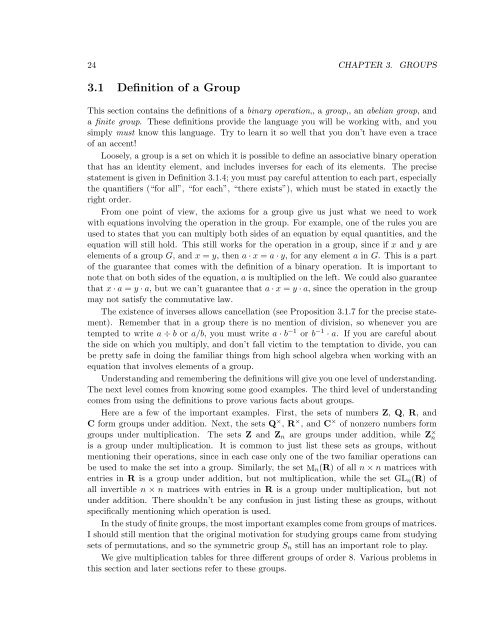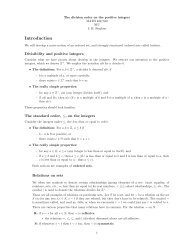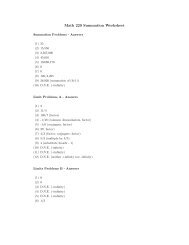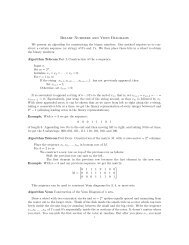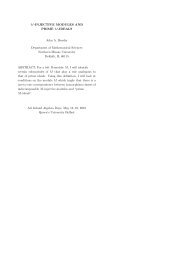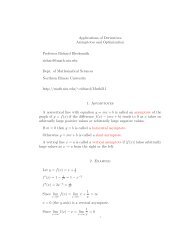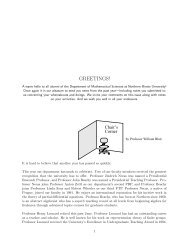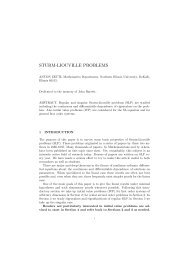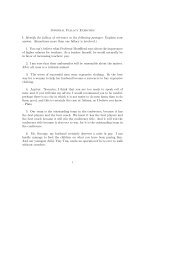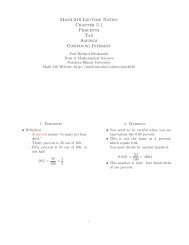abstract algebra: a study guide for beginners - Northern Illinois ...
abstract algebra: a study guide for beginners - Northern Illinois ...
abstract algebra: a study guide for beginners - Northern Illinois ...
Create successful ePaper yourself
Turn your PDF publications into a flip-book with our unique Google optimized e-Paper software.
24 CHAPTER 3. GROUPS<br />
3.1 Definition of a Group<br />
This section contains the definitions of a binary operation,, a group,, an abelian group, and<br />
a finite group. These definitions provide the language you will be working with, and you<br />
simply must know this language. Try to learn it so well that you don’t have even a trace<br />
of an accent!<br />
Loosely, a group is a set on which it is possible to define an associative binary operation<br />
that has an identity element, and includes inverses <strong>for</strong> each of its elements. The precise<br />
statement is given in Definition 3.1.4; you must pay careful attention to each part, especially<br />
the quantifiers (“<strong>for</strong> all”, “<strong>for</strong> each”, “there exists”), which must be stated in exactly the<br />
right order.<br />
From one point of view, the axioms <strong>for</strong> a group give us just what we need to work<br />
with equations involving the operation in the group. For example, one of the rules you are<br />
used to states that you can multiply both sides of an equation by equal quantities, and the<br />
equation will still hold. This still works <strong>for</strong> the operation in a group, since if x and y are<br />
elements of a group G, and x = y, then a · x = a · y, <strong>for</strong> any element a in G. This is a part<br />
of the guarantee that comes with the definition of a binary operation. It is important to<br />
note that on both sides of the equation, a is multiplied on the left. We could also guarantee<br />
that x · a = y · a, but we can’t guarantee that a · x = y · a, since the operation in the group<br />
may not satisfy the commutative law.<br />
The existence of inverses allows cancellation (see Proposition 3.1.7 <strong>for</strong> the precise statement).<br />
Remember that in a group there is no mention of division, so whenever you are<br />
tempted to write a ÷ b or a/b, you must write a · b −1 or b −1 · a. If you are careful about<br />
the side on which you multiply, and don’t fall victim to the temptation to divide, you can<br />
be pretty safe in doing the familiar things from high school <strong>algebra</strong> when working with an<br />
equation that involves elements of a group.<br />
Understanding and remembering the definitions will give you one level of understanding.<br />
The next level comes from knowing some good examples. The third level of understanding<br />
comes from using the definitions to prove various facts about groups.<br />
Here are a few of the important examples. First, the sets of numbers Z, Q, R, and<br />
C <strong>for</strong>m groups under addition. Next, the sets Q × , R × , and C × of nonzero numbers <strong>for</strong>m<br />
groups under multiplication. The sets Z and Zn are groups under addition, while Z × n<br />
is a group under multiplication. It is common to just list these sets as groups, without<br />
mentioning their operations, since in each case only one of the two familiar operations can<br />
be used to make the set into a group. Similarly, the set Mn(R) of all n × n matrices with<br />
entries in R is a group under addition, but not multiplication, while the set GLn(R) of<br />
all invertible n × n matrices with entries in R is a group under multiplication, but not<br />
under addition. There shouldn’t be any confusion in just listing these as groups, without<br />
specifically mentioning which operation is used.<br />
In the <strong>study</strong> of finite groups, the most important examples come from groups of matrices.<br />
I should still mention that the original motivation <strong>for</strong> <strong>study</strong>ing groups came from <strong>study</strong>ing<br />
sets of permutations, and so the symmetric group Sn still has an important role to play.<br />
We give multiplication tables <strong>for</strong> three different groups of order 8. Various problems in<br />
this section and later sections refer to these groups.


